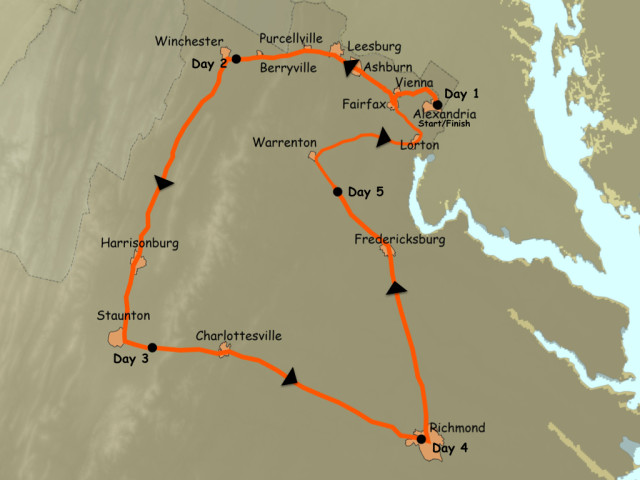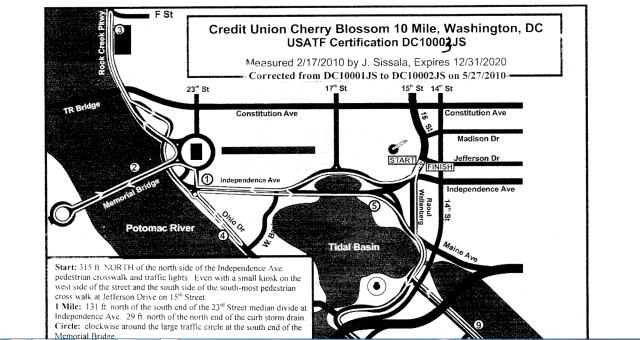 Have you ever finished a race thinking you’ve just set a personal record time, only to look down at your watch to discover that the race might have been too short? If so, you’re not alone.
Have you ever finished a race thinking you’ve just set a personal record time, only to look down at your watch to discover that the race might have been too short? If so, you’re not alone.
Many races — from 5ks to marathons — are, in fact, not the actual advertised distance. When planning and organizing a race, the race director may opt to settle for “close enough” or just “pretty accurate,” which may result in the race being as far off as anywhere from 50 yards to a couple miles.
Fortunately, many race directors do ensure that their course has been accurately measured and is at least the stated distance, in which case the race will be described as “USATF (U.S.A. Track and Field) certified.”
The process of certifying races, however, is not as simple as entering start and end points in Google Maps or using GPS systems; it is a lengthy and meticulous process that not many people know how to do, let alone have put much thought towards.
The truth is, while many races last a couple of hours or less for most runners, the planning of certified races starts months beforehand.
The course certification process begins when the race director decides to plan a certified race, after which he or she will ideally plan a preliminary route and hire another person to do the certifying. It does not take a paid expert to measure courses — just an individual who is able to follow the specific guidelines laid out by USATF.
Two such race certifiers in the Washington, D.C. area are Bob Thurston and Lyman Jordan, both of whom have been in the business for more than 20 years.
Thurston was an active distance runner for much of his life and started getting interested in course certification methods in 1980, when he directed a race and realized how difficult it was to recruit someone to certify the course.
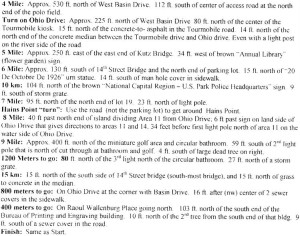
Thurston recruited Jordan at an Road Runners Club of America convention in 1984. Jordan now operates a company called Race Resources, which helps ensure successful running and triathlon events.
They both certify at least 30 races per year, including everything from one-mile races to marathons.
When asked about the best way to measure a course, Thurston pulled out his bicycle.
“It’s the best way to measure a course in a straight line,” Thurston explained.
Other modern measurement devices, such as GPS units and bicycle cyclometers, can provide good estimates for non-race runs and bike rides, but they are not accurate enough for USATF.
The most common course measuring method involves a “Jones-Oerth” counter, which is a counter that can be attached to the front wheel of the bicycle.
The bike must first be calibrated over a steel-taped calibration course, which is to be laid out and marked over a flat, straight road.
After the bike is calibrated, the bike must be ridden on the race course at least twice. USATF guidelines state that both rides must be within 0.08 percent of the distance of each other, or a third ride is required; once this requirement is met, the longer of the two rides is to be used. The route taken by the certifier is known as the shortest possible route, or SPR, which refers to the shortest route that a runner could take along the course and have an official finish.
Following the actual measuring of the course—known as the field work—the course certifier must complete paperwork and draw a detailed map of the course for the race director.
To provide a picture of how long course certification takes, the entire process for a 5k, for example, takes about two to three hours in the field, according to Thurston. The documentation, however, can take about 10 or more hours.
“The biking isn’t what takes the longest time,” Jordan said. “What takes the longest is crunching the numbers, making sure the data is accurate and creating a good quality map.”
On how long it takes to certify a marathon, Thurston joked, “It pretty much eats up your whole life.”
Thurston retired from his full-time teaching job last year but says he feels just as busy now. “I don’t understand how I found time to do this when I had a full-time job,” he joked.
However, Thurston added that it’s important that people not get the wrong idea.
“It’s a lot of fun, and I love what I do,” Thurston said. “I get to ride my bike, which I enjoy, and I meet so many interesting people who I wouldn’t have ever met if I never got into this.”
Thurston is also well aware of the pure necessity of having certified race courses. Without such standardized guidelines, he explained, there would be no way to confirm the accuracy of personal records, let alone world records for set distances. Additionally, unless a runner enters races whose distances are accurately measured, his or her race times are not necessarily useful, and he or she won’t be able to accurately access progress.
Running certified races are also required in order to qualify for high-profile races, including the Boston and New York City Marathon.
Despite taking all the necessary measures required to certify a course, it does not come without obstacles.
Thurston recalls that some runners years ago got off course at the Marine Corps Marathon.
“By the time I noticed, it was too late to rectify the situation,” Thurston said. “Instead, I had to figure out a way to compensate for the missed distance by altering the end of the route.”
Thurston acted fast. After making all appropriate calculations, he immediately got in touch with the marines manning the aid station at the end of the course, who followed Thurston’s instructions, moved the guiding cones and hauled the aid station supplies in time to save the runners from an unofficial finish time.
In fact, you can find Thurston riding his bicycle out in front of the runners at this year’s MCM, just like he’s been doing for the past 20 years and will continue doing as long as he is able.
“I would like to see the day when all races are certified or measured to certification standards,” Thurston said.
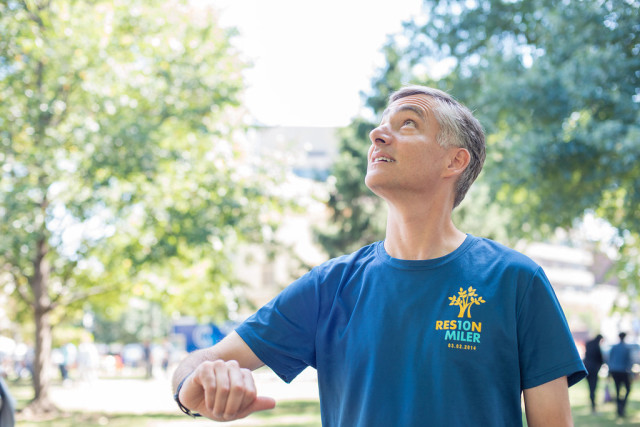
Whither GPS?
The USATF and Road Running Technical Council made the following statement explaining why your GPS watch isn’t as accurate as the official source measurement:
GPS devices work by receiving signals from satellites. The quality of different GPS units can vary, but all of them can be affected by conditions such as buildings in urban environments or heavy overhead tree cover that interfere with reception of the satellite signals and can cause them to be inaccurate.
Race courses Certified by USATF are measured by a proven method that incorporates the calibration of measuring devices against a steel tape and are verified by multiple measurements.
Race courses are measured along a well-defined path called the “SPR”—the Shortest Possible Route that a runner can possibly run. Most runners don’t actually run the SPR, so the distance recorded by their GPS device will usually be longer than the certified length of the course, even though the course was properly measured along the SPR according to USATF rules.
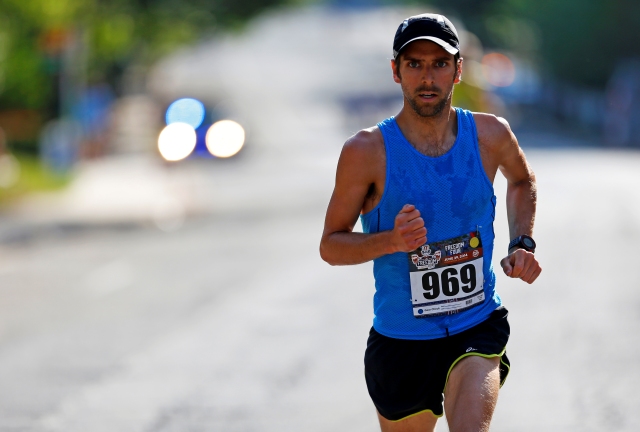
Running 500 miles in five days probably sounds like a crazy idea. That’s exactly what Amos Desjardins wants people to think.
“Sometimes it takes doing something crazy if you really want to get people’s attention,” he said.
He’s bound to get hungry with that kind of routine, but his discomfort is dwarfed by the cause he is promoting — the plight of one million Virginians, 12 percent of the population, without access to fresh and healthy food.
Each of the estimated million steps he will take will represent one of those hungry Virginians.
“I run a lot, obviously,” he said. “It’s a passion of mine. But food issues are also a really big passion of mine, and I really wanted to find a way to bring the two things together to bring awareness. People often don’t necessarily realize the magnitude.”
He grew up around farms, still grows his own fruits and vegetables and follows a vegan diet. Over the years, he has volunteered at Carpenter’s Shelter, which works to serve more than 1,000 homeless and formerly homeless children and adults in Virginia each year.
Desjardins started planning and training for the run after he decided last summer that he wanted to use running to help Virginia residents in particular who are suffering from hunger.
Since then, he has partnered with the Federation of Virginia Food Banks, a nonprofit state association that supports food banks in providing food, funding, education, advocacy and awareness services and programs throughout the commonwealth.
The federation currently has seven food bank locations in Virginia, each of which distributes millions of pounds of food to hundreds of agencies every year.
Leslie Van Horn, the federation’s executive director, has been working with Desjardins to help coordinate the route and ways they can work together to help spread awareness.
They thought September, Hunger Action Month, would be an appropriate time to hold the run.
“We’re so honored that Amos chose to work with us,” she said. “We’ve never had anybody do anything like this before in all of the federation’s time. It’s mind-boggling, really.”
Van Horn’s hope for the run is for it to eliminate stigmas that surround food issues in Virginia.
“Many people think that people who need assistance and go to food banks aren’t doing their part to help themselves, but that simply isn’t always the case,” Desjardins said.
Additionally, according to the recently-released 2014 Food Deserts in Virginia Task Force Report, Virginia’s low-access rate is 17.8 percent, which exceeds the national low-access rate of 7.3 percent. Food-insecurity rates are even lower than the statewide rate in more affluent areas in Northern Virginia such as Alexandria, Arlington, Fairfax and Manassas.
Desjardins will start Aug. 30 in Alexandria, at the corner of Union and King St. He’ll head to Winchester, Harrisonburg, Charlottesville and Richmond, before heading back to Alexandria by Sept. 3.
Each day will start at about 5 or 6 a.m., and hit a 10:00/mile pace. That will work out to 16 hours and 40 minutes of running per day, each of which will likely end in a hotel bath tub ice bath.
In the time he can spare, he will be stopping at the federation’s food banks in Along the way, Desjardins will be stopping to conduct meet and greets at four of the Federation’s food banks—in Augusta County, Richmond, Fredericksburg and Lorton. He hopes people will donate food at each of his appearances, or anytime they see the grey Jetta that will serve as his support vehicle.
“Amos is determined and can really accomplish anything he sets his mind to,” his wife Abigail said. “But it takes the help of friends and family to pull off something of this magnitude.”
Amos’ support team will include Abigail and his two of his close friends, Timothy Fitzgerald and Jeffrey Owens. Along the way, he will be followed by someone on a bicycle at all times and the support vehicle where roads allow; likely Owens.
“He texted me saying I was probably the only person crazy enough to come along for 500 miles on a bike, and I immediately agreed,” Owens said. “Amos has always been incredibly driven, and I’ve always wondered how he was going to use his boundless energy.”
The running joke among Amos’ friends, he said, is that no one’s ever seen him spent, even having run anywhere from 5ks to 70-plus-mile races.
When asked where he gets his energy to run, Amos responded without hesitation, “Life. Other people. I get a lot of joy and happiness from seeing others happy.”
He runs several ultras a year, and hopes to run next year’s Western States 100-Mile, one of the country’s most renowned and increasingly coveted ultras. If he is accepted, Western States will be his first 100-mile race.
Well, his sixth. After Sept. 3.
Follow Amos’ progress on his Facebook page.
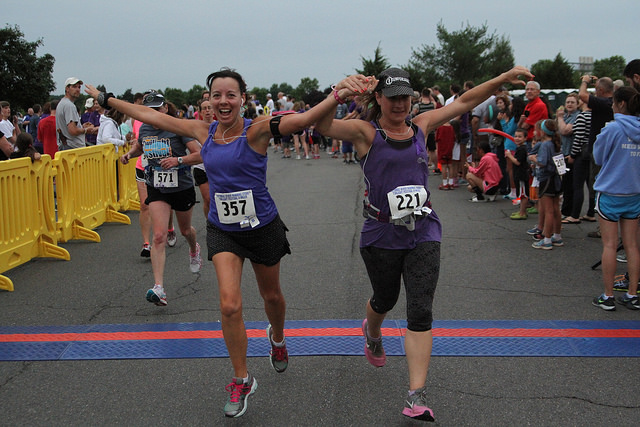
The sounds of laughter, music and families with friendly dogs and moonbounce-loving children filled the start area of the ninth annual Twilight Festival 4 Miler June 21 in Ashburn.
But a subtle somberness permeated the race and paralleled the evening’s overcast skies.
[button-red url=”http://www.zippyraceresults.com/search.php?ID=4075″ target=”_self” position=”left”] Four Mile Results [/button-red]On March 12 of this year, Ashburn area mom Jaime Rowley had her life tragically taken while out for a morning run. Her family and friends have created the Run for Jaime Foundation, which promotes runner safety awareness and raises money to help families who have also suffered the loss of a family member. The Twilight Festival this year will benefit the foundation set up in memory of Jaime.
Michele Wiggins, Jaime’s older sister, said that the foundation was inspired by the community. “We were so overwhelmed with all the support and help that was given to us that we said, ‘Okay, the girls (Jaime’s daughters) are taken care of, and now all this money and support and events need to help someone else,” Wiggins said.
More than 800 runners came out to show their support, many of whom sported purple t-shirts with the hashtag #RunforJaime on the back, while others came for the competition.
First male- and overall- finisher 24-year-old Neal Darmody of Durham, N.C. said he didn’t expect to come out on top, after having taken last year off from racing.
So far, though, Darmody has seen nothing but success. Earlier this year, he finished first in Potomac River Running’s Reston 10 Miler and came in second at last weekend’s Lawyer’s Have Heart 10k.
Darmody drove up from Duke University the night before the Twilight 4 Miler in hopes of placing in the top three.
“From the start, I didn’t think I was going to win it. The lead runner was way ahead, but I slowly worked my way up to him,” Darmody said.
Dromody ended up finishing in 20:06, nearly 50 seconds ahead of second-place finisher 32-year-old Teresa Fekensa Beyisa.
Beyisa, originally from Ethiopia, finished in 20:54. He appeared less competitive and was all smiles at the finish.
“I run 5ks, 10ks, half marathons, full marathons, everything. Today, the people here were very nice, the course was good, and so I am happy,” Beyisa said.
Third in the men’s division was 28-year-old Dustin Whitlow from Arlington, who finished 10 seconds after Beyisa at 21:04.
In the women’s division, 26-year-old Danielle Orton of Washington, D.C. held a 6:15 min/mile average pace and finished in 25:03, nearly a full minute before second place finisher 26-year-old Anna Holt-Gosselin, who finished in 26 minutes even.
Thirty-one-year-old Elizabeth Heering of Rockville ran as part of Potomac River Running’s racing team in her age division and finished in third.
“When I first came in, I just wanted to have fun with it, but I was pleased to find that I was able to stay with the front runners,” Heering said. “I loved the course. It was flat and fast and a great race overall.”
For many runners, though, competition was the last thing on their mind. Potomac River Running owner Ray Pugsley emphasized that the Twilight Festival is more about the family-centric atmosphere than the race itself.
“When we started the race in 2006, we wanted an event where people and families could hang out and have fun after, not just run on a Sunday morning then go home,” Pugsley said.
As a family race, participants ranged from young to old and everyone in between.
Alexander Dvorznak, just five years old—or “five-and-a-half,” in his words—ran the Twilight Festival’s one-mile fun run option with his older sister and mom and dad. The Dvorznaks say they like to run numerous races throughout the year as a family as a fun way to stay healthy. And if there’s one word to describe the Twilight Festival, Alexander says it’s “fun.”
At the other end of the spectrum was Robert Gurtler from The Plains, Va., who at 79 years old was the oldest Twilight 4-Miler runner this year. This race marked Gurtler’s 56th race just this year. Gurtler had run a race earlier that day, had registered for a race the next morning, and he said he ran about 130 races in 2013.
“I’m not a competitive runner anymore, so I just run for fun,” Gurtler said. “Now I’m at the back of the pack with the ladies pushing their babies or talking about their boyfriends,” he said with a smile. “And now I can have a beer.”
For Kurt Collier of Haymarket, Va, the Twilight 4 Miler marked Collier’s 52nd race in 52 weeks—a goal he set out to accomplish to test his own limits and to help inspire others. But the race also held another special meaning.
Collier, 48, lost his left leg when he was hit by a car more than 10 years ago while training for a triathlon. Collier recalls, “I was found straddling my bike, obviously in shock.” He was fortunate enough to survive his injuries and has since regained his strength and competed in numerous races and in the U.S. Paralympics while wearing a prosthetic leg.
“Everyone tonight had great energy, and to support the cause and raise awareness for runners’ safety is so worthwhile,” Collier said. “It’s a tribute, and now for me it’s time to sit back and reflect.”
For Wiggins, the Twilight Festival offered the opportunity to reflect as well. In the spring and summer of 2014, 10 or so local races have Jaime on their list of registrants. Wiggins, who said was never into running, decided to run the races in honor of her sister.
“As a non-runner, I had no idea how tight the running community was and how cool they were and how giving and caring they all are about one another,” Wiggins said. “Going to the events, I see why she liked it so much. It opened my eyes, and now I understand why she loved it so much.”
“If Jaime could see everything the community has done and what’s being done tonight, I can’t even imagine what she would be thinking,” Wiggins said. “I think Jaime would be amazed.”


